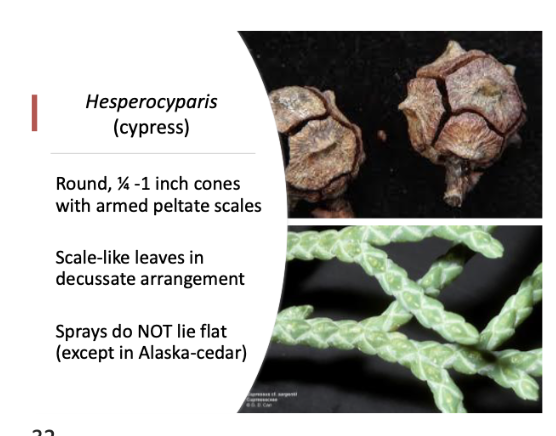midterm 1 dendrology
1/82
There's no tags or description
Looks like no tags are added yet.
Name | Mastery | Learn | Test | Matching | Spaced |
|---|
No study sessions yet.
83 Terms
tree
plant, >20ft, central woody stem(trunk)
shrub
plant, <20ft, multiple woody stems
vine
plant with multiple trailing stems
conifer
mostly evergreen, do not drop leaves/cones. soft wood, leave needle or scale-live. have seeds in cones. late successional long living organisms.
softwood
wood from gymnosperms(conifers)
gymnosperm
“naked” seeds that are not enclosed in friuits
broadleaf
flowering plants, hardwood and angiosperm. there are monocots and dicots
hardwood
wood from broadleaf trees
angiosperm
seeds enclosed within a fruit, develops ovary of flower
primary growth
growth from buds. change in length or height
secondary growth
growth in width or girth from vascular cambium
annual rings
layers of secondary growth
levels of taxonomic rank*
Kingdom, Division, Class,Order, Family, Genus, Species (KDCOFGS)
King Phillip Came Over For Good Spaghetti
species*
a group of organisms that share a lot of characteristics. can reproduce with each other and produce fertile offspring.
pinophyta
conifers
magnoliophyta
broadleaf
common names
numerous, in regional languages, describes something about the tree
scientific names
ordering things based on shared characteristics. taxonomic rank
sexual reproduction
two parents, combination of genetic material, unique offspring
vegetative reproduction
one parent, duplication of genetic material, offspring is just like parent
evergreen
green leaves year round, always on the tree
deciduous
leafless for part of the year. drops leaves all at once. season dependent
pollination
transfer of pollen from stamen to pistil. From cone to seed. (male to female)
fertilization
when pistil and stamen fuse together and create a seed
seed dispersal
when plant seeds are moved from the parent plant to a different location.
ovary
female reproduction organ in flowers
pollen
tiny grains that carry male gametes for reproduction
flower
reproductive of angiosperms
fruit
mature ripened ovary of a flowering plant
seed cone
reproductive organ in gymnosperm
pollen cone
male cone that produces pollen
seed
product of fertilization that contains embryo for food supply
monoecious
having both male and female reproductive parts in the same plant
dioecious
having male and female reproductive parts in separate plants
pollination vectors
wind water and animals
seed dispersal vectors
wind, water, animals, gravity
angiosperm reproduction
uses both pistil and stamen for reproduction
conifer reproduction
uses pollen bearing cones(male) and seed bearing cones(female)
seed dormancy
seeds remain inactive and do not reproduce/germinate
germination
seed absorbs water, swells, breaks seed coat. embryo grows, using stored food for energy
Provenance
geographical location that the seed is from. population adapts to local environment.
genet vs ramet
a genet is a clonal colony(group), while a ramet is a clone(one)
rhizome
underground stem
layering
rooted stem
root collar
where the trunk meets the root system
burl
outgrowth of wood on side of tree. often looks kind of like a tumor.
adventitious
in an unusual anatomical position. roots/buds
methods of vegetation propagation
rooted “cuttings”, grafting, micropropagation
habitat
the physical/biotic enviornment a species is adapted to and survives in
natural range
where the species is found. species is assumed to have evolved there or made its way there without help from humans and other organisms.
naturalized range
an area that a species has established without assistance, outside of its normal range. outside of original natural range
environmental factors that influence habitat
climate, soils, topography, biota
*(CLORPT) not the same but same idea from SOIL205. (Climate, organisms, topography, parent material, time to evolve)
orographic precipitation (process and effect)
when air is forced to rise over the mountain range. this leads to cooling/condensation, which leads to precipitation.
habitat generalist
species that can thrive in a wide range of environments and factors.
habitat specialist
adapted to specific habitats with specific/narrow needs
species variety/subspecies
different species have different characteristic due to evolution and reproduction. some species will have different characteristics based on CLORPT
endemic
native and restricted to a certain place
how is climate different west vs east of the cascades*
Different elevation. The climate west of the cascades is typically wetter and more mild due to the low elevation/sea level. the climate east has more mountains and a wider ranger of topography. There is orgohrgaphic precipitation in the west.
how do mountains affect habitat? (2)*
create microhabitats(Lower parts of mountain vs upper parts have different climates).
Water cycle. Can store larger amounts of water at varying temperatures depending on climate. Some areas will be covered in ice/snow, while some will be sunny and woodlands.)
Tundra
Very cold
No trees, sedges, forms, low shrubs
Carix(sedges) and Salix(willows)
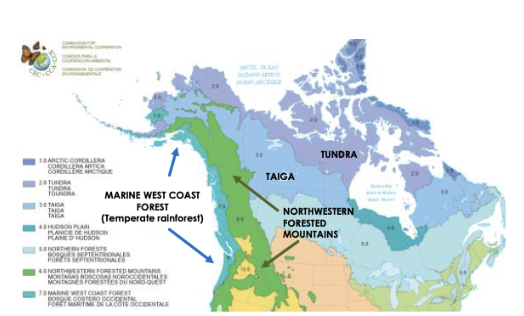
Taiga
Northern Coniferous Forest, Glaciated, numerous lakes and bogs
Long cold winters mild summers. Dominated by snow.
Permafrost(gelisol soil)
low tree biodiversity
Birch( Betula) and Spruce(Picea)
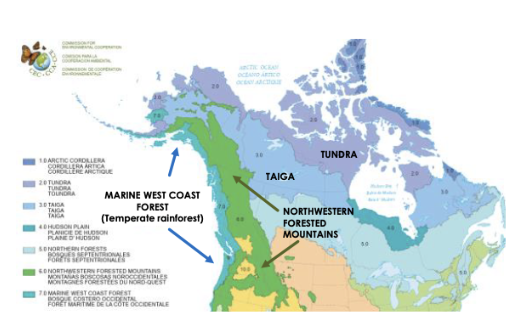
Temperate Rain ForestMarine West Coast Forests)
Low seasonal fluctuation for temperature
High precipitation and long growing seasons
Huge conifers(dominated)
rot resistant wood, and epiphytes present
Spruce(Picea), Douglas Fir(Pseudotsuga)
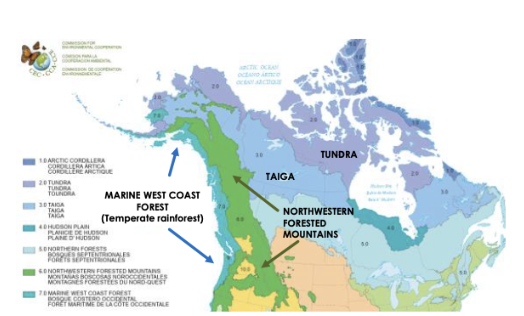
Northwestern Forested Mountains Zones
3 Zones - Alpine, Mountain, Lowland
Moderated by proximity to Pacific Ocean
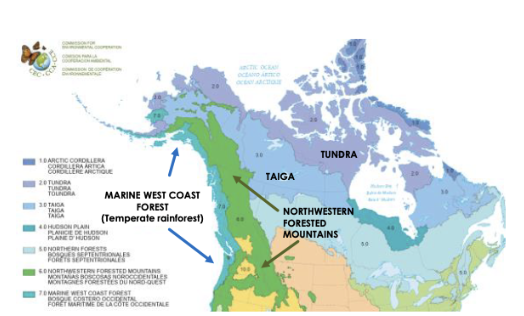
Northwestern Forested Mountains - Alpine
similar to tundra, too cold for trees.
grasses, sedges, and forbs
Northwestern Forested Mountains - Montane
Dense confier forest.
Fir(Abies), Spruce(Picea), Pine(Pinus)
Cool dry summers, snow winters, short growing.
Northwestern Forested Mountains - Lowland
Drier, warmer climate, vegetation depends on location
Mediterranean California
Coastal and inlands of California.
mild, wet winters, dry summers
Lots of Broadleafs
Oaks(Quercus) and Manzanita(Arctostaphylos)
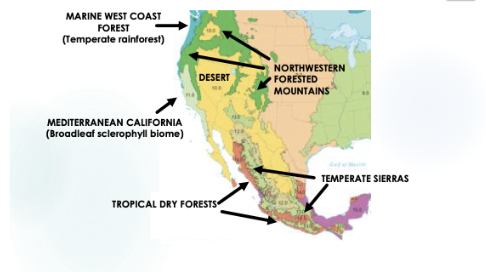
Topical Dry Forests
So-Cal, warmer climates. distinct seasons
Deciduous trees
Poplar(Populous) and Willow(Salix)
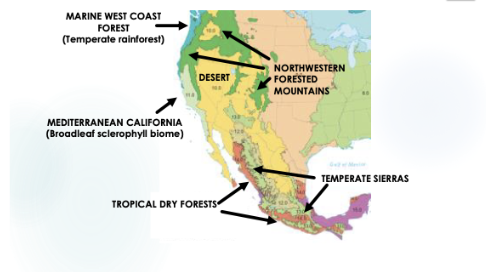
Temperate Sierras
Sierra Nevada mountains
cold winters, warm dry summers
Lots of conifers
Pine(Pinus) and Fir(Abies)
Cypress Family
Mostly evergreen trees and shrubs
Usually scale like and decussate.
Leaves and twigs shed together
Pine Family
Mostly evergreen trees and shrubs
NEEDLES
Hard Yellow Pines
2/3 needles per fascicle. fascicle sheath is persistent. cones have thick armed scales
Soft White Pines
5 needles per fascicle, thin unarmed cone scales, gradual early to late wood, deciduous
Pinus(Pine) Characteristics
Acicular needles (2,3,5) Ovate cones with spirally arranged scales
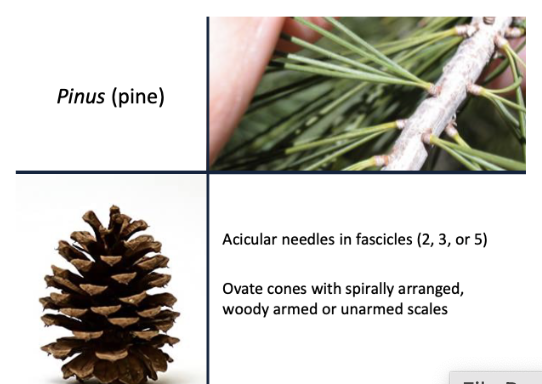
Abies(Fir) Characteristics
blunt, linear needles. round and flat leaf scares. errect, barrel shaped cones.
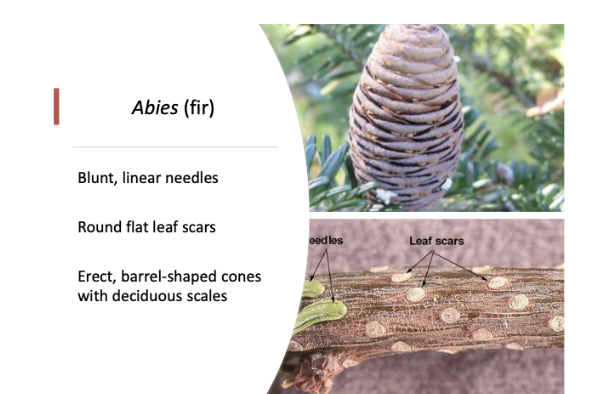
Pseudotsuga(Doug. Fir) Characteristics
Petiolate, linear needles, raised leaf scares, three point come bracts. sharp and reddish buds. bark looks like bacon
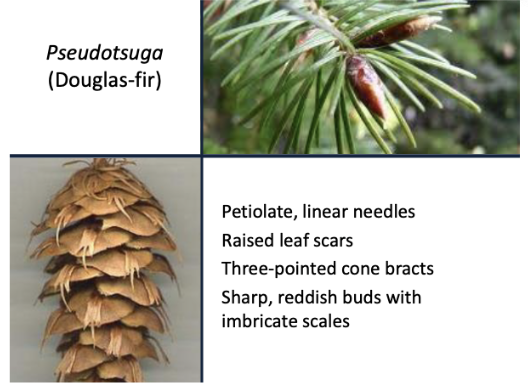
Tsuga(Hemlock) Characteristics
Petiolate, short linear needles. raised leaf scares. small cyclindfral ones with papery scales

Picea(Spruce)
Sharp, acicular needles on wood pegs. cylindrical cones with papery scales
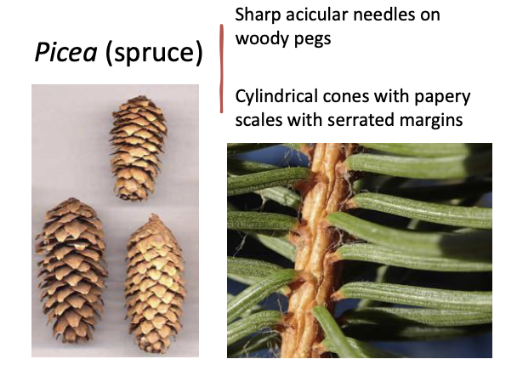
Larix(Larch)
deciduous needles on woody spur shoots. small cylindrical cones
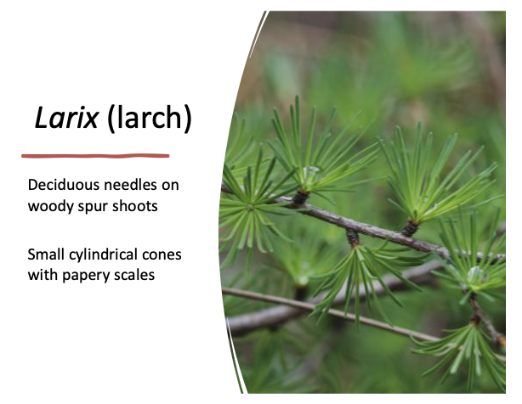
Thuja(Thuja) Characteristics
Scale-like leaves in decussate arrangement, flattened sprays. Small ovoid cones with several pairs.
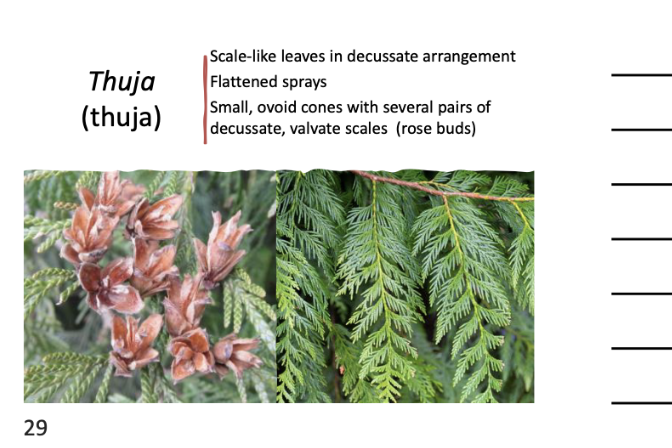
Chamaecyparis(White Cedar)
scale like leaves, decussate arrangement. flattened sprays. pea sized round cones.
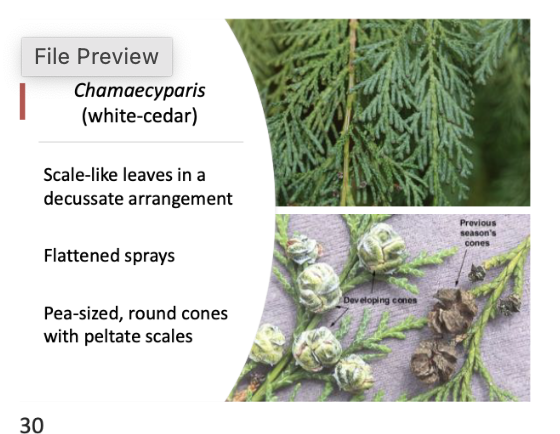
Calocedrus(Incense Cedar)
Elongated and scale like leaves. flattened sprays, ovate cones
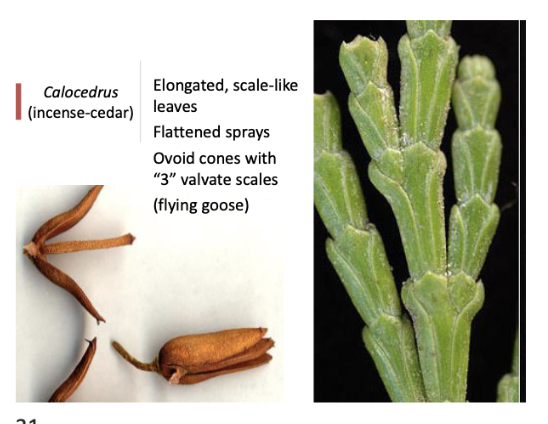
Hesperocyparis(Cypress) Characteristics
Round 1/4-1 inch cones with armed pelate scales. scale like leaves in decussate arrangement. sprays do NOT lie flat
